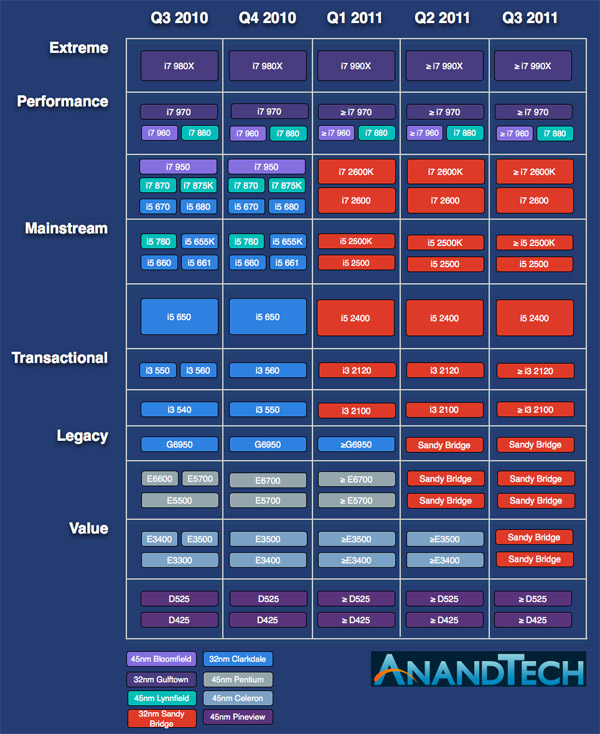The Sandy Bridge Preview
by Anand Lal Shimpi on August 27, 2010 2:38 PM ESTThe Roadmap & Pricing
I’ve defined the launch parts earlier in this article, but now I’m going to put them in perspective. When Intel provides its partners with roadmaps it also provides them with an idea of where future CPUs slot into various segments/price points. For example, Intel’s LGA-1366 roadmap tell us that in the “Extreme” market segment Intel only has a single product offering: the Core i7 980X. And in Q1 2011 the 980X gets replaced by the 990X.
Usually based on this information you can get a general idea of how much future products will cost - or at least what they will be comparable to. In this example the 990X will most likely be priced at whatever the 980X is priced at. Products may change, but the price people are willing to pay in a certain market segment usually doesn’t.
What we have below is the Intel roadmap, with Sandy Bridge included, for Q3 2010 through Q3 2011. The further out you go in a roadmap the lower your accuracy becomes, so I wouldn’t worry too much about us not seeing LGA-2011 on there yet.
It’s based on this roadmap that I mentioned some pricing earlier. If all stays the same, the Core i7 2600K will take the place of the Core i7 950, currently priced at $562. The 2600 will fit somewhere around the 680 and 875K ($342) and the 2500K will replace the i5 760/655K ($205 - $216).
The cheapest Sandy Bridge at launch will be the Core i3 2100, which will replace the i3 560 at around $138.
Now pricing is always a huge variable, but I have to say, based on the performance you’re about to see - these parts would be priced right.











200 Comments
View All Comments
AndreC - Saturday, August 28, 2010 - link
Hi there.. I`m currently a freelance 3D generalist.. and I was going to upgrade my old Core 2 Quad QX6700 with a Core i7 980X. But now i`m not that confident. Sandy bridge looks amazing, I was sad seeing the new socket for sandy bridge, it does not compell me to buy a new motherboard now... does anyone know if the 1366 socket will stick with the nex gen High end market? I dont want to shoot myself in the foot here.AndreC - Saturday, August 28, 2010 - link
Sorry dind`t read the last frase...Great Review btw. cheers
sdsdv10 - Saturday, August 28, 2010 - link
As noted in the Intel roadmap in the article, for at least part of 2011 they will be sticking with 1366 for the release of the Core i7 990X (to replace the 980X). However, after that the Intel performance platform will switch over to socket LGA-2011. Here is a quote from the articlea (page 3)."Original Nehalem and Gulftown owners have their own socket replacement to look forward to. In the second half of 2011 Intel will replace LGA-1366 with LGA-2011. LGA-2011 adds support for four DDR3 memory channels and the first 6+ core Sandy Bridge processors."
AndreC - Saturday, August 28, 2010 - link
Yeah.. as I said "Sorry dind`t read the last frase..." but thx anyway..It`s a shame to be always changing sockets, but probabily a necessity to evolve the technology.
Kaihekoa - Saturday, August 28, 2010 - link
Having the first chips target the mainstream market is a very smart move by Intel because that's where AMD makes it's money. I'm honestly not impressed by the performance numbers, but I am impressed by the overall performance, power consumption, and pricepoints for these next gen CPUs. What I'm really looking forward to is the performance segment of Sandy Bridge.mino - Saturday, August 28, 2010 - link
Intel's mainstream is not where AMD's is.Especially in 2011.
Ontario:
. . . CPU - above Atom, under everything else
. . . GPU - 5450/Sandy class
Lliano:
. . . CPU - 2C Sandy class
. . . GPU - 5650 class (at least 3x Sandy)
Bulldozer Desktop(8C):
. . . CPU - 4C Sandy Class
. . . GPU - discrete 5750+ class
So basically AMD's platform in the Intel's "mainstream" $200+ class will be a Bulldozer with discrete GPU. Aka AMD's high end stuff.
silverblue - Saturday, August 28, 2010 - link
Not sure I agree with that. From AMD's own figures, Bulldozer is significantly faster than STARS. It would be more realistic to expect Bulldozer to perform closely to Sandy Bridge, however we really need more benchmarks before we get a true idea. Bulldozer looks great on paper, but that's virtually all we have so far.In any case, you compared Bulldozer to "4C Sandy Class", which would be an 8-thread Sandy Bridge, and thus - at least relatively - high end. And I'm not getting into the core/module argument again... ;)
mino - Sunday, August 29, 2010 - link
What I wanted to point out is that Intel sees the 4C Sandy as a "mainstream" part.Reason being they are moving HUGE amounts (compared to AMD) of $150-$250 parts.
On the other hand, AMD sees the mainstream at $100-$200 and that is a Llano market.
For AMD, Zambezi is high-end that justifies discrete GPU.
And Yes, Bulldozer 8C should compare with 4C Sandy favorably, (it would mostly go to pricing).
tatertot - Sunday, August 29, 2010 - link
BD 8C is going to be up against 8C and 6C Sandy on LGA-2011 in the client space.mino - Monday, August 30, 2010 - link
am sure AMD WOULD like it that way. But no. Not really.8C Bulldozer versus 6C Sandy might actually be competitive.
However 32nm SOI is a new process so we might as well forget about 4GHz parts for now.
Also, Sandy 6C is Q4 part and 8C is most probably 2012 part.